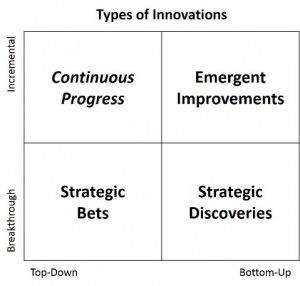So, you don’t think you are an entrepreneur? How business analysis helps innovation.
 You might think you are not going to start a company or build a business from the ground up. Maybe you don’t want to risk your livelihood or work crazy hours or wear multiple hats like an entrepreneur does. We suggest you think again. Business analysis practitioners can and should be entrepreneurial by being intrapreneurs, a prime way that helps drive innovation.
You might think you are not going to start a company or build a business from the ground up. Maybe you don’t want to risk your livelihood or work crazy hours or wear multiple hats like an entrepreneur does. We suggest you think again. Business analysis practitioners can and should be entrepreneurial by being intrapreneurs, a prime way that helps drive innovation.
Today’s business world is quickly changing. With all the emphasis on innovation, your organization needs business analysts and project managers to be entrepreneurial. You might never become an actual entrepreneur. But, your organization’s success and your career will increasingly depend on how you can help your organization adapt and grow and compete. Competition has always been part of business, but it seems to be getting more intense and dynamic. To illustrate this point, the average lifespan of a company on the Standard & Poor’s 500 list was 67 years back in the 1920s. Today the average length is only 15 years.1
Perhaps the best way for most BAs to become entrepreneurial is by being an intrapreneur. We cited a definition of that term in an earlier article as someone who is:
“An inside entrepreneur, or an entrepreneur within a large firm, who uses entrepreneurial skills without incurring the risks associated with those activities. Intrapreneurs are usually employees within a company who are assigned a special idea or project, and are instructed to develop the project like an entrepreneur would.”2
There is one part of this definition we don’t like: it is hard to be entrepreneurial if you don’t incur risks. So we would add to this definition that intrapreneurs indirectly assume risks on behalf of the organization. There might be financial risk if the new products and services we create lose money. There are product risks if the changes we instigate have defects. Additionally, intrapreneurs take personal risks within the organization, which could materialize if the products or services we work on don’t succeed. We will come back to that challenge later in the article.
Intrapreneurial Example. Our first stints as intrapreneurs came at the bank that we both worked at early in our careers. Much of our work was similar to a business analyst, but that term had not been invented back in the 1970s yet.
No matter what we were called, we were definitely change agents for the bank, reviewing department processes, procedures, “EDP” requirements, and organization structures. We recommended improvements and new services, both manual and automated. It was creative and a lot of fun.
We were both happy there as employees, and yet looking back we were expected to be intrapreneurs in the sense that we helped the bank move to new possibilities. We “disrupted” the status quo (to use the popular term in lean startup circles). That disruption sometimes came at some organization risk when we recommended streamlining procedures that were overly controlling. We also took on personal risk when we made recommendations, although we did not view it that way at the time.
Bank management thought the organization risk was worth it because it helped the bank achieve better customer service, efficiency, and control. We took on the personal risk because we earnestly believed our recommendations were helping the company.
Types of Innovations
Why are intrapreneurs important? When organizations introduce new products or enhance existing ones, our guess is today they would all say they want to “innovate.” We feel that the intrapreneurial function is the most practical and repeatable way to implement many innovations. However, to think about “innovation” as being a uniform process is overly simplistic. In the article “The Innovation Strategy Big Companies Should Pursue,”3 Tony Davila lists four types of innovations, depending on whether they are top-down or bottom-up and the extent to which they are “breakthroughs” or incremental:
- Incremental: Continuous Progress and Emergent Improvements
- Breakthroughs: Strategic Bets and Strategic discoveries.
We have summarized these four types in Table 1. It is common to associate innovation with breakthroughs, given how often Apple and 3M are used as examples. At Apple, some of Steve Jobs’ major successes like the iPad and iPhone were strategic bets. The Post-It Note product from 3M is an example of a strategic discovery type of innovation.
Table 1: Types of Innovations
We think it is important to also include incremental change as innovation since there are many more opportunities to accomplish this type in today’s workplace. Given there are more opportunities, most potential intrapreneurs would likely work on incremental innovations in their career. The particular type of innovation possible is also highly dependent on your organization’s culture. Armed with this knowledge, potential intrapreneurs need to work within the organization culture. We will have better success by employing innovation processes that are compatible with the culture.
Davila also notes that organizations today are least likely to have processes in place for “Strategic Discoveries.”3 To address this point, we assembled the following table with thoughts about how business analysis helps contribute to the various innovation types.
| Innovation Type | Prime Question | Key Techniques/Skills |
| Continuous Progress | What problem are you trying to solve? | Root Cause Analysis, Consulting Skills |
| Emergent Improvements | What problem(s) have we not addressed yet? | Root Cause Analysis, Lean Six Sigma/Business Process Improvement |
| Strategic Bets | What opportunity do you see with the strategic bet? | Benchmarking, Business Cases (especially Feasibility and Cost-Benefit Analysis) |
| Strategic Discoveries | What frustrates people today with the status quo? | Brainstorming, Benchmarking, Observation |
Table 2: Working with Innovation Types
Final Thoughts
Will my Company Support This? A writer on intrapreneurship, Dan Schawbel, has written an insightful article on intrapreneurship. He maintains that
“Smart companies want you to become an intrapreneur because it fuels business growth and allows them to gain a competitive advantage in their industry.”4
We couldn’t agree more and at the same time realize this may seem a daunting proposition. . Many companies are not structured today to foster intrapreneurship, yet there are indications that organizations are moving in the right direction.
In the same article, Schawbel describes a recent study in conjunction with American Express that found that “58% of managers are either very willing or extremely willing to support employees…on a new business opportunity within their company.”4 That sounds like fertile ground for intrapreneurship if you ask us. Chances are your company would agree with this notion and support you if you want to move into that kind of role.
We will explore in future articles how people practicing business analysis can contribute as intrapreneurs.
This article was first published on April 20th in the BA Times.
=*=*=*=*=*=*=*=*=*=*=*=*=*=*=*=*=*=*=*=*=*=*=*=*=*=*=*=*=*=*=*=*=*=*=*=*=*=*=
[1] Source: “Innovation Isn’t Just About Brainstorming New Ideas,” by Ira Kalb, https://www.businessinsider.com/innovate-or-die-a-mantra-for-every-business-2013-7. Downloaded April 12, 2015.
[2] Investopedia definition of intrapreneur, https://www.investopedia.com/terms/i/intrapreneur.asp. Downloaded October 24, 2014.
[3] “The Innovation Strategy Big Companies Should Pursue,” by Tony Davila, https://hbr.org/2014/06/the-innovation-strategy-big-companies-should-pursue/. Downloaded April 12, 2015.
[4] “Why Companies Want You To Become an Intrapreneur” by Dan Schawbel, Forbes Magazine. https://www.forbes.com/sites/danschawbel/2013/09/09/why-companies-want-you-to-become-an-intrapreneur/. Downloaded February 8, 2015.

 New Horizons
New Horizons
 Project Management Academy
Project Management Academy
 Six Sigma Online
Six Sigma Online
 Velopi
Velopi
 Watermark Learning
Watermark Learning
 Login
Login





 New Horizons
New Horizons
 Project Management Academy
Project Management Academy
 Velopi
Velopi
 Six Sigma Online
Six Sigma Online
 Watermark Learning
Watermark Learning